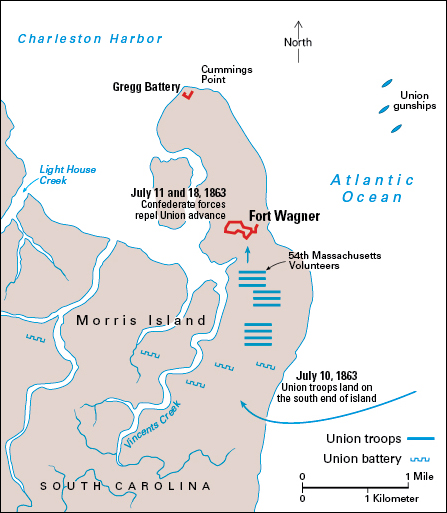Fort Wagner, Battle of, was a hard-fought Confederate victory during the American Civil War (1861-1865). The battle took place in July 1863 at Fort Wagner, also called Battery Wagner, on Morris Island near the harbor of Charleston, South Carolina. Confederate forces repelled the Union attempt to capture the fort. However, the battle became famous for the heroic efforts of an all-black Union regiment. The regiment’s bravery helped win greater acceptance for African American soldiers fighting for the Union.
Background.
After the Civil War began in 1861, the North proclaimed a naval blockade of Southern ports. The blockade severely reduced Southern trading activities. Charleston, a leading port in the South, was a focus of Northern blockade efforts throughout the war.
In April 1863, Union ships attacked Fort Sumter, one of the forts protecting Charleston’s harbor. Confederate General Pierre G. T. Beauregard led the defense of Charleston. Confederate batteries (groups of cannons) held off the Union assault.
The battle.
On July 10, Union troops landed on the south end of Morris Island, near the entrance to Charleston’s harbor. The next day, Union soldiers advanced on Fort Wagner but were repulsed by heavy fire. For the next week, Union ships bombarded the fort.

On July 18, Union soldiers under Brigadier General Truman Seymour advanced on the fort yet again. At the front of the attack were the 54th Massachusetts Volunteers. The 54th Massachusetts, led by Colonel Robert Gould Shaw, was the first African American regiment recruited in the North during the war.
The 54th Massachusetts suffered heavy casualties (soldiers killed, wounded, or missing), and Shaw himself was killed. William H. Carney, a member of the 54th Massachusetts, famously rescued the regiment’s flag after the flag bearer was shot. Union forces withdrew by nightfall.
In the course of the two assaults on the fort, about 300 Union soldiers were killed. More than 1,000 were wounded, and about 550 were missing or captured. On the Confederate side, only about 200 men were killed or wounded.
Aftermath.
Union forces continued to bombard Charleston’s defenses for months after the failed assault on Fort Wagner. The Confederates abandoned the fort on September 6.
Charleston remained in Confederate hands until February 1865, when Southern forces evacuated. At that time, Union forces under General William T. Sherman, having completed their march through Georgia, were threatening to cut off the city by their march through the interior of the Carolinas. The main Confederate armies surrendered two months later.
See also Carney, William Harvey ; Civil War, American (The use of black troops) ; Shaw, Robert Gould .
